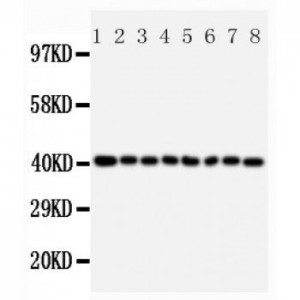More info
Overview
Long Name | Antibody Type | Antibody Isotype | Host | Species Reactivity | Validated Applications | Purification |
| peptidylprolyl isomerase D | Polyclonal | IgG | Rabbit | Human, Mouse, Rat | IHC-P, WB | Immunogen affinity purified. |
Immunogen | ||||||
| A synthetic peptide corresponding to a sequence at the C-terminus of human PPID(351-370aa KQKIKAQKDKEKAVYAKMFA), different from the related mouse and rat sequence by one amino acid. | ||||||
Properties
Form | Lyophilized |
Size | 100 µg/vial |
Contents | Antibody is lyophilized with 5 mg BSA, 0.9 mg NaCl, 0.2 mg Na2HPO4, 0.05 mg Thimerosal and 0.05 mg NaN3. *carrier free antibody available upon request. |
Concentration | Reconstitute with 0.2 mL sterile dH2O (500 µg/ml final concentration). |
Storage | At -20 °C for 12 months, as supplied. Store reconstituted antibody at 2-8 °C for one month. For long-term storage, aliquot and store at -20 °C. Avoid repeated freezing and thawing. |
Additional Information Regarding the Antigen
Gene | PPID |
Protein | Peptidyl-prolyl cis-trans isomerase D(PPIase D) |
Uniprot ID | Q08752 |
Function | PPIases accelerate the folding of proteins. It catalyzes the cis-trans isomerization of proline imidic peptide bonds in oligopeptides. Proposed to act as a co-chaperone in HSP90 complexes such as in unligated steroid receptors heterocomplexes. Different co-chaperones seem to compete for association with HSP90 thus establishing distinct HSP90-co-chaperone-receptor complexes with the potential to exert tissue-specific receptor activity control. May have a preference for estrogen receptor complexes and is not found in glucocorticoid receptor complexes. May be involved in cytoplasmic dynein-dependent movement of the receptor from the cytoplasm to the nucleus. May regulate MYB by inhibiting its DNA- binding activity. Involved in regulation of AHR signaling by promoting the formation of the AHR:ARNT dimer; the function is independent of HSP90 but requires the chaperone activity. Involved in regulation of UV radiation-induced apoptosis. Promotes cell viability in anaplastic lymphoma kinase-positive anaplastic large- cell lymphoma (ALK+ ALCL) cell lines. May be involved in hepatitis C virus (HCV) replication and release. |
Tissue Specificity | Widely expressed. |
Sub-cellular localization | Cytoplasm. Nucleus, nucleolus. Nucleus, nucleoplasm. |
Sequence Similarities | Belongs to the cyclophilin-type PPIase family. PPIase D subfamily. |
Aliases | 40 kDa peptidyl-prolyl cis-trans isomerase antibody|40 kDa peptidyl-prolyl cis-trans isomerase D antibody|Cyclophilin related protein antibody|Cyclophilin-40 antibody|Cyclophilin-related protein antibody|CyclophilinD antibody|CYP-40 antibody|CYP40 antibody|CYPD antibody|Estrogen receptor-binding cyclophilin antibody|Peptidyl-prolyl cis-trans isomerase D antibody|Peptidylprolyl isomerase D antibody|PPIase D antibody|PPID antibody|PPID_HUMAN antibody|Rotamase antibody|Rotamase D antibody |
Application Details
| Application | Concentration* | Species | Validated Using** |
| Western blot | 0.1-0.5μg/ml | Human, Rat Mouse | AssaySolutio's ECL kit |
| Immunohistochemistry(Paraffin-embedded Section) | 0.5-1μg/ml | Human, Rat Mouse | AssaySolutio's IHC/ICC Detection kit |
AssaySolution recommends Rabbit Chemiluminescent WB Detection Kit (AKIT001B) for Western blot, and Rabbit Peroxidase IHC/ICC Detection Kit (AKIT002B) for IHC(P). *Blocking peptide can be purchased at $65. Contact us for more information

Anti-PPID antibody, ASA-B1560, Western blotting
Lane 1: Rat Brain Tissue Lysate
Lane 2: Rat Pancreas Tissue Lysate
Lane 3: Rat Liver Tissue Lysate
Lane 4: JURKAT Cell Lysate
Lane 5: RAJI Cell Lysate
Lane 6: CEM Cell Lysate
Lane 7: HL-60 Cell Lysate
Lane 8: HT1080 Cell Lysate
Lane 1: Rat Brain Tissue Lysate
Lane 2: Rat Pancreas Tissue Lysate
Lane 3: Rat Liver Tissue Lysate
Lane 4: JURKAT Cell Lysate
Lane 5: RAJI Cell Lysate
Lane 6: CEM Cell Lysate
Lane 7: HL-60 Cell Lysate
Lane 8: HT1080 Cell Lysate

Anti-PPID antibody, ASA-B1560, IHC(P)
IHC(P): Rat Brain Tissue
IHC(P): Rat Brain Tissue



